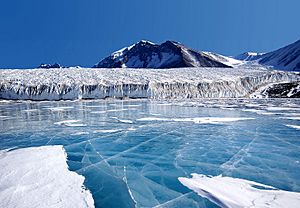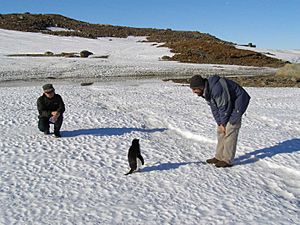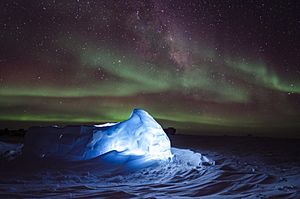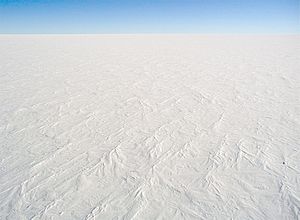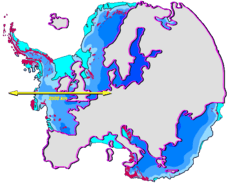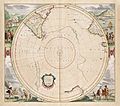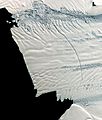Antarctica facts for kids
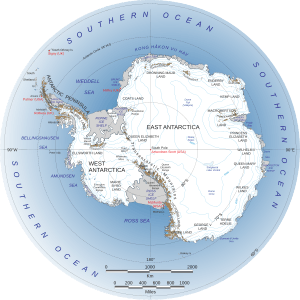 |
|
| Area |
|
|---|---|
| Population | 0 (about 1000 people living temporarily) |
| Dependencies | |
| Time zones | None |
| Internet TLD | .aq |
Antarctica is the southernmost continent on Earth. It sits right on the South Pole. Most of it is south of the Antarctic Circle. The Southern Ocean surrounds Antarctica. It is the fifth-largest continent. Its area is about 14.0 million square kilometers (5.4 million square miles). This makes it smaller than Asia, Africa, North America, and South America. About 98% of Antarctica is covered by a thick layer of ice. This ice is usually at least 1.6 kilometers (1.0 mile) thick.
Antarctica is, on average, the coldest, driest, and windiest continent. It is also the highest continent. Antarctica is considered a desert. It gets very little precipitation, only about 200 mm (8 inches) near the sea each year. Inland, it gets even less. No humans live in Antarctica permanently. However, about 1,000 to 5,000 people live there temporarily. They stay at science stations throughout the year. Only plants and animals that can handle extreme cold live there. Animals include penguins, seals, nematodes, tardigrades, and mites. Plant life includes some grass and shrubs, algae, lichen, fungi, and bacteria.
People first saw the continent in 1820. For the rest of the 19th century, Antarctica was mostly forgotten. This was because of its harsh environment, few resources, and isolation. The name Antarctica was first officially used for the continent in the 1890s. Scottish mapmaker John George Bartholomew is said to have used it.
The Antarctic Treaty was signed in 1959 by 12 countries. Many more countries have signed it since then. Now, 46 countries are part of the treaty. This treaty says that military activities and mineral mining are not allowed. But it strongly supports scientific research. It also helps protect the continent's ecozone. More than 4,000 scientists from different nations work together there.
Contents
What is Antarctica's Geography Like?
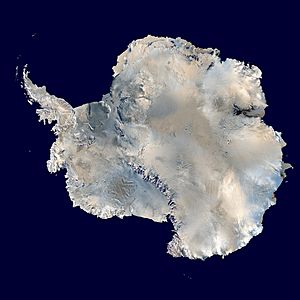
Antarctica is located around the South Pole. Most of it is south of the Antarctic Circle. This is one of the five main lines of latitude on world maps. The Southern Ocean surrounds the continent. Antarctica has rivers, and the Onyx is the longest. Antarctica covers over 14.2 million square kilometers. This is almost twice the size of Australia. It is the fifth-largest continent. Its coastline is nearly 18,000 kilometers (11,000 miles) long. About 44% of the coast is floating ice shelf. Another 38% is ice walls on rock. Ice streams or glacier edges make up 13%. Only 5% is exposed rock.
There are lakes under the continental ice sheet. Most of these are in the McMurdo Dry Valleys or other ice-free areas. Lake Vostok, found under Russia's Vostok Station, is the largest subglacial lake in the world. Scientists once thought it was sealed off for millions of years. Now, they believe its water changes every 13,000 years. This happens as ice slowly melts and refreezes. In summer, the ice at the lake edges can melt. This forms temporary liquid moats. Antarctica has both salty and freshwater lakes.
The Transantarctic Mountains divide Antarctica into West Antarctica and East Antarctica. These mountains stretch from Victoria Land to the Ross Sea. Most of Antarctica is covered by the Antarctic ice sheet. This ice sheet is about 1.9 kilometers (1.2 miles) thick on average. It covers all but a few ice-free areas. These areas are mostly along the coast. Several Antarctic ice streams flow into the many Antarctic ice shelves.

East Antarctica includes Coats Land, Queen Maud Land, Enderby Land, Mac. Robertson Land, Wilkes Land, and Victoria Land. Most of this region is in the Eastern Hemisphere. The East Antarctic Ice Sheet covers most of East Antarctica. Many islands surround Antarctica. Most of these islands are volcanic and quite new in terms of geology. The islands of the Kerguelen Plateau are an exception. The oldest of these formed around 40 million years ago.
Vinson Massif, in the Ellsworth Mountains, is the highest point in Antarctica. It stands at 4,892 meters (16,050 feet) tall. Mount Erebus on Ross Island is the world's southernmost active volcano. It erupts about 10 times a day. Ash from its eruptions has been found 300 kilometers (190 miles) away. There is evidence of many volcanoes under the ice. If they become more active, they could affect the ice sheet. Dome Argus in East Antarctica is the highest ice feature. It is 4,091 meters (13,422 feet) high. It is one of the coldest and driest places on Earth. Temperatures there can drop to -90°C (-130°F). The yearly precipitation is only 1 to 3 centimeters (0.4 to 1.2 inches).
What is Antarctica's Climate Like?
Antarctica is the coldest continent on Earth. It was ice-free until about 34 million years ago. Then, it became covered with ice. The coldest natural air temperature ever recorded was -89.2°C (-128.6°F). This was at the Russian Vostok Station in Antarctica on July 21, 1983.
Antarctica is a frozen desert with very little rain. The South Pole itself gets less than 10 centimeters (4 inches) of snow per year. In winter, temperatures in the middle of the continent drop to between -80°C (-112°F) and -89.2°C (-128.6°F). In summer, temperatures near the coast can reach between 5°C (41°F) and 15°C (59°F).
Sunburn is a common problem there. The snow surface reflects almost all the sun's ultraviolet light. Because of its location, Antarctica has long periods of constant darkness or constant sunlight. This creates unusual climates for humans.
East Antarctica is colder than West Antarctica. This is because it is at a higher elevation. Weather systems rarely move far into the continent. This keeps the center cold and dry. Even though there is little rain in the middle, the ice lasts a very long time. Heavy snowfalls are common on the coast. Up to 1.22 meters (48 inches) of snow have fallen in 48 hours there.
At the edge of the continent, strong katabatic winds blow off the polar plateau. These winds often reach storm speeds. In the interior, wind speeds are usually moderate. On clear summer days, the South Pole gets more solar radiation than the equator. This is because the sun shines for 24 hours a day at the Pole.
Antarctica is colder than the Arctic for three main reasons. First, much of the continent is over 3,000 meters (9,800 feet) above sea level. Temperatures get colder as you go higher. Second, the Arctic Ocean covers the North Pole area. The ocean's warmth moves through the ice. This stops Arctic temperatures from getting as extreme as Antarctica's land surface. Third, Earth is farthest from the Sun in July (Antarctic winter). Earth is closest to the Sun in January (Antarctic summer). This distance makes the Antarctic winter colder. But the first two reasons have a bigger effect.
The aurora australis, also known as the southern lights, is a beautiful glow in the night sky. It happens near the South Pole. It is caused by charged particles from the solar wind hitting Earth's atmosphere. Another unique sight is diamond dust. This is a cloud at ground level made of tiny ice crystals. It usually forms when the sky is clear. A sun dog is a bright "spot" that appears next to the real sun.
Life in Antarctica
Plants of Antarctica
Few land plants grow in Antarctica. This is because Antarctica does not have much water, sunlight, good soil, or warm temperatures. Plants usually only grow for a few weeks in the summer. However, moss, lichen, and algae do grow there. The most important living things in Antarctica are the tiny plankton that grow in the ocean.
Animals of Antarctica
One very important food source in Antarctica is krill. Krill are small, shrimp-like marine crustaceans. They are at the bottom of the food chain. They eat tiny phytoplankton and smaller zooplankton. Krill are a main food for larger animals. So, whales, penguins, seals, and even some birds in Antarctica depend on krill.
Whales are the largest animals in the ocean. They are mammals, not fish. This means they breathe air and do not lay eggs. Many different kinds of whales live in the oceans around Antarctica. Whalers have hunted whales for hundreds of years for their meat and blubber. Today, most whaling happens in the Antarctic area.
Penguins only live south of the equator. Several different kinds live in and around Antarctica. The biggest ones can stand almost 1.2 meters (4 feet) tall. They can weigh nearly 40 kilograms (100 pounds). The smallest kinds are only about 30 centimeters (one foot) tall. Penguins are large birds that swim very well but cannot fly. They have black backs and wings with white fronts. Penguins have a thick layer of blubber to keep them warm. Their feathers are packed very tightly and overlap. This creates another thick cover. They also have a layer of woolly down under their feathers. The feathers themselves are covered with a type of oil that makes them waterproof. Penguins eat fish and are at home in the ocean. They come onto land or ice to lay their eggs and raise their chicks. These animals nest together in huge groups.
How Was Antarctica Discovered?
For a long time, people believed there was a huge continent in the far south of Earth. They thought this Terra Australis (Southern Land) would "balance" the lands in the north. These northern lands included Europe, Asia, and North Africa. People have believed this since the time of Ptolemy (1st century AD). He suggested this idea to keep the world's lands balanced. Maps often showed a large land in the south. In the late 17th century, people found that South America and Australia were not part of this mythical "Antarctica." However, geographers still thought Antarctica was much bigger than it really was.
European maps continued to show this unknown land. Then, Captain James Cook's ships, HMS Resolution and Adventure, crossed the Antarctic Circle. This happened on January 17, 1773, and again in December 1773 and January 1774. Cook actually got within about 75 miles (120 kilometers) of the Antarctic wikt:coast. But he had to turn back because of thick ice in January 1773.
The first confirmed sightings of Antarctica were by three different men in 1820. According to different groups, ships led by Fabian von Bellingshausen (a Russian captain), Edward Bransfield (a British captain), and Nathaniel Palmer (an American seal hunter) all saw Antarctica. The first recorded landing on mainland Antarctica was by the American sealer John Davis. He landed on West Antarctica on February 7, 1821. However, some historians are not completely sure about this claim.
People slowly began to discover and map different parts of Antarctica. This was slow work because they could only work in the summer. Finally, a map was made. People then started talking about exploring the land itself, not just the sea. This would be very difficult. They would have to break through the ice around Antarctica. Then they would need to land and bring enough supplies to live on while exploring.
The first serious exploration of the Antarctic land was the Nimrod Expedition. Ernest Shackleton led it from 1907–09. They were the first to climb Mount Erebus and reach the South Magnetic Pole. Shackleton and three others made several firsts in December 1908 – February 1909. They were the first humans to cross the Ross Ice Shelf. They also crossed the Transantarctic Mountain Range (using the Beardmore Glacier). They were the first to step onto the South Polar Plateau.
Robert Falcon Scott was a very well-known explorer. He wanted to be the first person to reach the South Pole. At the same time, another team from Norway led by Roald Amundsen also started their journey. They both raced to the South Pole. Amundsen won because he used his sleigh dogs very well. Scott had used ponies and motor sleds. When Scott reached the South Pole, he found a message from Amundsen. It showed that Amundsen had already been there.
On his way back, Scott and three friends faced a terrible blizzard. They froze to death while waiting for it to end. People found them eight months later. They also found Scott's records and diary. He had written in it until the day he died.
Climate change and global warming are now affecting Antarctica. This is especially true for the Antarctic Peninsula.
People Who Live in Antarctica
People who live in Antarctica stay there for a short time to learn more about the continent. Most of them are scientists. They live in national science stations, usually on the coast. Some bases are far from the sea, like at the South Pole. Scientists study the weather, animals, glaciers, and the Earth's atmosphere. Some scientists drill ice cores. This helps them learn about past weather. People working in Antarctica must be careful. A blizzard can start at any time. When they go far from their shelter, they must always take lots of food, just in case.
Today, people explore Antarctica using snowmobiles. These are faster than dogs and can pull heavier loads. Many people visit Antarctica just for a short trip. Some companies in South America offer vacations to Antarctica. People pay to travel there on a ship. Some people even take their own boats.
Related pages
Images for kids
-
A fossil leaf from the Glossopteris plant found in Antarctica.
-
An image of the largest hole in the ozone layer recorded in September 2006.
-
Emperor penguins with their young chicks.
-
Orange lichen (Caloplaca) growing on the Yalour Islands.
-
Trash on the shoreline at Bellingshausen Station on King George Island, photographed in 1992.
-
Adélie Land, shown in a drawing by Jules Dumont d'Urville from 1846.
-
The Nimrod Expedition of 1907–1909 (left to right): Frank Wild, Ernest Shackleton, Eric Marshall and Jameson Adams.
-
The "ceremonial" South Pole, at Amundsen–Scott Station.
-
The cruise ship Silver Cloud in Wilhelmina Bay.
-
An aerial view of McMurdo Station, the largest research station in Antarctica.
See also
 In Spanish: Antártida para niños
In Spanish: Antártida para niños


